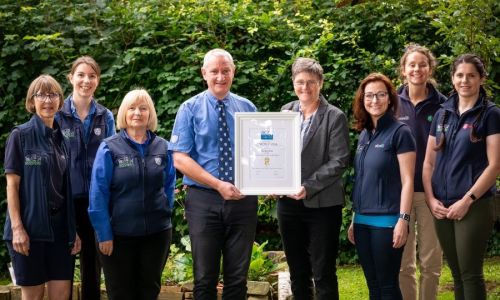The Veterinary Carbon Calculator - Getting Started
Do you want to understand your practice's environmental impact and set a carbon action plan? Here we give you a quick rundown of what you need to calculate your practice's carbon footprint and how to get started.
As a global society we sit at the brink of ecological and climate related disasters. Greenhouse gas emissions caused by human activities have already resulted in global warming of 1.1°C, which now teeters dangerously close to the 1.5°C of warming we are aiming to remain below to avoid the worst global consequences (IPCC, 2023).
So what as veterinary professionals can we do to help? For one thing, we need to understand the impacts of veterinary activities and veterinary practices on our environment, and develop climate literacy within our profession. Climate literacy means understanding the impacts of our actions and what we can do to reduce our environmental impacts and then taking action to mitigate our impacts. Find more information about our ‘Climate Literacy for Veterinary Professionals’ course here.
Calculating the carbon footprint of your veterinary practice will enable you to understand your practice's environmental impact, and help you get started with tailoring your carbon action plan.
Here we will give you a quick rundown of what data you need to calculate your carbon footprint, and where to find this. The Veterinary Carbon Calculator also comes with a handy Data Collection Checklist to help you collate all of your information in one place, and makes sure you have everything you need.
Top tips:
- It’s important to note that not every aspect of the list below will be applicable for every practice.
- We strongly recommend organisations with multiple sites complete a carbon calculation per site, in order to get an accurate measurement and set a targeted reduction plan.
- The Veterinary Carbon Calculator calculates the operational impact of your veterinary practice over the course of one year - therefore you need one year’s worth of data to input into the calculator.
- The data collection phase is the most time consuming, so we suggest dedicating some time for a member of staff to collate all of the data needed, and any member of the team can do this, meaning you do not need to take up any clinical time with this process.
So, what do you need?
Practice information:
This information helps us benchmark anonymised data across the profession.
Practice type: Small animal, farm, equine, exotics or mixed practice
Do you have RCVS Hospital status?
The number of full-time equivalent employees and full-time equivalent vets. If you don’t know or aren’t sure, ask your practice manager or HR department (if you have one).
Energy & Water:
Electricity used in kWh - you’ll need to check your meter readings or energy bills for the year. Are you on a renewable energy tariff or not?
Gas used (units of measurement vary between suppliers - check and be aware of which units apply to your practice) - check your meter readings or gas bills for the year.
Fuels such as LPG tanks (LPG covers both butane and propane) - check invoices for the year which will show the amount purchased.
Oil: Burning oil (kerosene used for heating) or gas oil (red diesel usually used for plants or generators) - check invoices for the year which will show the amount purchased.
Biofuels such as wood chips or wood pellets - check invoices for the year which will show the amount purchased.
Water supply and waste water: check your meter readings or bills for the year. Waste water treatment should be included on your water bill.
Travel:
Depending on the type of practice, travel may contribute a small or large amount to your overall footprint. There are a few ways you may record your business’ travel.
- Fleet travel: this includes all vehicles that belong to (or are leased by) the practice, and are used for business travel. You may either record this as miles or as litres of fuel purchases.
For fleet milage: you will need to know the engine size and fuel type, and the total mileage travelled in that vehicle in the year.
For fleet fuel in litres: you will need the total purchased litres of petrol or diesel for the year. Note you do not need to record fleet fuel in litres if it has already been accounted for in fleet mileage.
Grey fleet travel: this refers to vehicles that do not belong to the practice but are used for business travel (i.e. staff using their own vehicles). You ideally need to know the engine size and fuel type (if you don’t know the engine size there is an ‘average’ option), and the total miles travelled.
Collating the information on fuel purchased or miles travelled may depend on your practice reporting system. For example, fuel purchased can be tracked via fuel cards or business expense claim receipts showing the mileage of staff travel. If you only have the expenses paid information, you can calculate the miles travelled by dividing the total expenses paid by the rate paid per mile.
Waste:
Using resources responsibly and ensuring waste is segregated correctly can have a significant impact on your carbon footprint.
Domestic waste: weights (kgs) of each waste stream (e.g. general waste, recycling, food waste) are usually provided on invoices from waste companies.
Veterinary care waste: Typically weights (kg) are usually provided by your waste company, but some may be provided in litres (for example Sharps). Waste streams are typically broken down into infectious/sharps, cytotoxic, anatomical and pharmaceutical waste.
If your waste company measures in litres and you are unable to weigh your waste streams, you can use an approximate conversion of 0.4kg per litre of waste.
If you record your waste based on a number of bags rather than in litres or kgs, you can weigh a number of each of the 'types' of waste bags (clinical/general/ recycling) over a 'typical' week, and then record the average weight for each type. You can then use the average weight x number of bags for the calculator. This is obviously not as accurate as having a weight for each bag, but helps to provide a rough figure to use.
Refrigerants and Anaesthetic gases:
Anaesthetics such as Isoflurane/Sevoflurane bottles or Nitrous Oxide canisters – Invoices from the year will show the quantity of bottles or canisters purchased, and the size of each bottle.
Refrigerants within air conditioning or refrigeration equipment (if applicable) – Servicing records will show any refrigerant that has been added into the system (i.e. recharged). Systems are not always recharged but speak with your servicing company for advice.
And just remember not every aspect of the list below will be applicable to every practice.
So what’s next?
You will then have all the data you need across energy & water, waste, travel, and refrigerants & anaesthetic gases to successfully complete your carbon calculation. Head to the Veterinary Carbon Calculator to get started and make a positive change on your practice’s environmental impact.
Once you have your calculation you can better understand your practice’s environmental impact, and you will also be able to get started with tailoring your carbon action plan. By the time you come to calculate your next year's carbon footprint you can showcase and celebrate the successful reductions you have made in your environmental impact and overall footprint.
“We recently completed our carbon audit using Vet Sustain’s Veterinary Carbon Calculator. This is a great resource and much easier to use than one I tried out previously. I found it simple to complete, and lots of the data was really easily available. For us, the anaesthesia section result was quite surprising - we already use Humphrey circuits to try and reduce flow rates, but we are going to look into what else we can do in this area. Waste was more challenging as our collections are based on a number of bags, not weight. However we are looking at this as a result, to monitor the total amount and distribution of waste across clinical waste, general waste and recycling, to reduce the total number of bags and increase recycling.”
Laura Mather MRCVS, Director, Greenbay Vets.
Need some more help getting started?
We have a helpful video walking you through the process of using the calculator - head over to the Veterinary Carbon Calculator page here to check it out.
Note
Are you a member of the British Veterinary Association (BVA), the British Veterinary Nursing Association (BVNA), British Small Animal Veterinary Association (BSAVA) and Society of Practising Veterinary Surgeons (SPVS)? You can save 33% on the price of a calculation, reducing the price down to £100 +VAT (usual price £150 +VAT). Contact your member organisation for your discount code.
The Veterinary Carbon Calculator is currently for UK practices, find out more.
References:
IPCC. (2023) AR6 Synthesis Report: Climate Change 2023. Available at: https://www.ipcc.ch/report/sixth-assessment-report-cycle/


